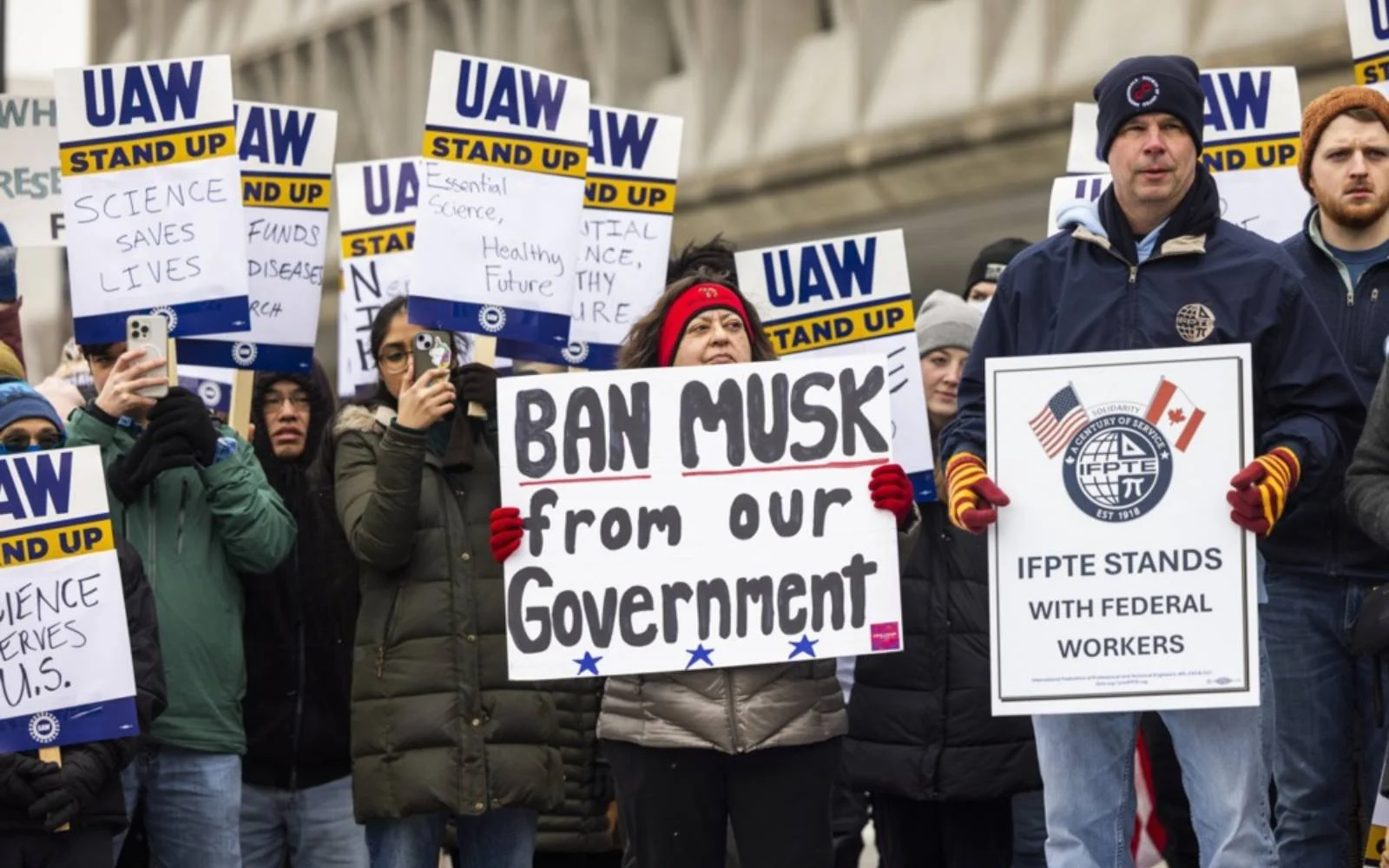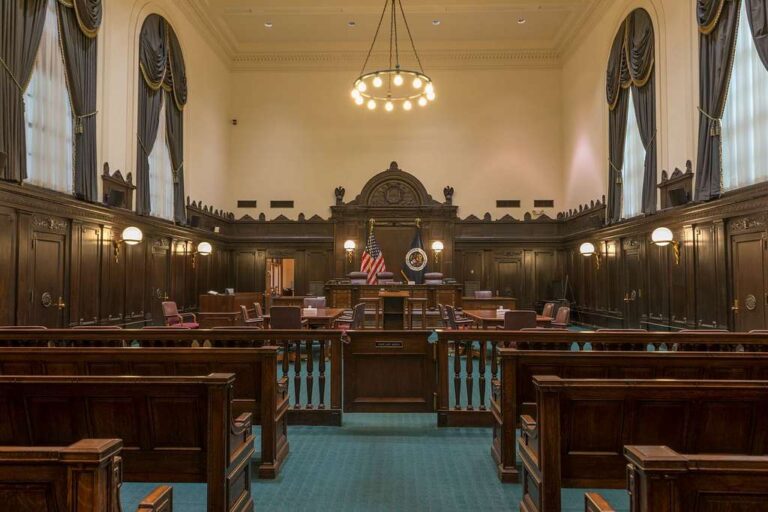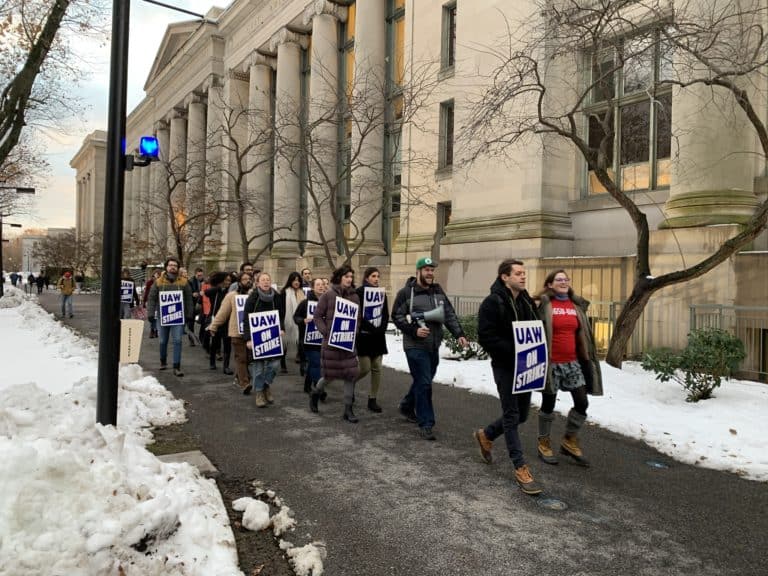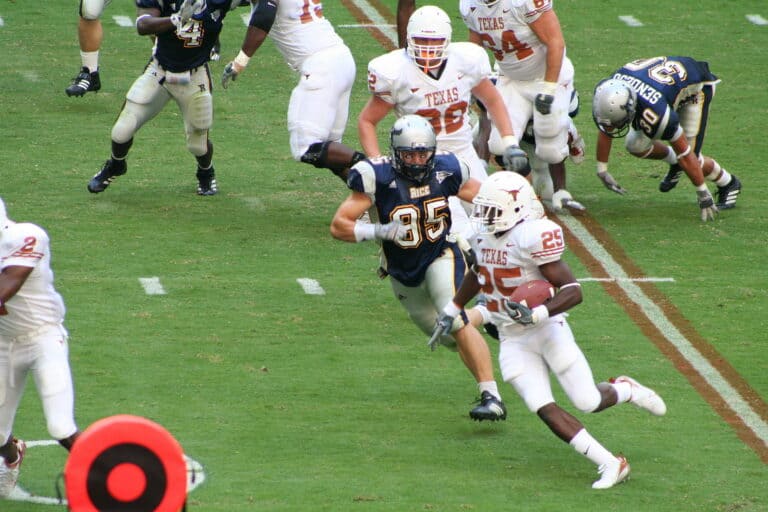
Andrew Strom is a union lawyer based in New York City. He is also an adjunct professor at Brooklyn Law School.
Elon Musk has literally been brandishing a chain saw to symbolize his efforts to fire federal workers. Across the country, the federal government employs about 3 million civilians. The Defense Department employs about 750,000 of these, far more than any other department. Federal employees do a wide variety of jobs, but many of them work at regulatory agencies, doing their best to enforce the laws that are on the books. About 15,000 work for the Department of Labor (DOL) and about 1,200 work at the National Labor Relations Board. While life threatening cuts at the U.S. Agency for International Development’s Global Health program have gotten some media attention, we shouldn’t ignore the threats to these low-profile agencies that protect American workers.
Right-wingers like J.D. Vance and Neil Gorsuch like to deride federal employees by referring to them as “bureaucrats.” The implication is that these individuals are simply processing forms or placing red tape in the paths of entrepreneurs. In fact, they are often enforcing rules that protect the powerless and keep people safe. And sometimes the rules they enforce just attempt to create a level playing field for competitors. It might be helpful to think about the National Football League, an organization that many Trump supporters love. Each game features 22 players on the field, and 7 officials, who one might think of as bureaucrats. The rule book the officials enforce is 232 pages, which includes 89 pages of rules, plus a “casebook” interpreting the rules, and a separate instant reply casebook. That’s a lot of red tape. Fans may not like it when their team is penalized, but all those officials are there to ensure that players aren’t exposed to unnecessary risks and that neither team is cheating – they keep players from grabbing each other by the facemask or hitting each other after a play ends, and they ensure neither side has an extra player on the field. And without the officials, there wouldn’t be any games.
Federal employees at the DOL and the NLRB perform a similar service to NFL officials. The Occupational Safety and Health Administration (OSHA), part of the DOL, protects the health and safety of workers on the job. But, unlike the NFL, where there is one official for every three players on the field at all times, OSHA is woefully understaffed. According to the AFL-CIO, there is only one OSHA inspector for every 80,000 workers in the country. OSHA reported that 5,283 workers were killed on the job in 2023, and there were an additional 2.6 million non-fatal workplace injuries and illnesses. The AFL-CIO estimates that 120,000 Americans die each year from occupational diseases (such as long-term exposure to toxic substances).
The work performed by the staff at the NLRB rarely garners headlines, but the agency is the only avenue for enforcing the rights guaranteed by the National Labor Relations Act. While I often wish the NLRB would move faster, the work done by the staff at the NLRB can’t be done by robots. When workers file charges, a human being has to investigate those charges, asking the right questions of witnesses, and knowing which documents to look for. More than 60% of charges are dismissed at the investigatory stage, minimizing the burden on employers. The vast majority of cases that aren’t dismissed settle at this stage. But, if a case doesn’t settle, it is scheduled for trial before an Administrative Law Judge, followed by a potential appeal to the Board Members in Washington. Congress wrote in a short six-month statute of limitations, realizing that there is a strong public interest in resolving labor disputes quickly. Slashing staff at the NLRB just means that each step in this process will take much longer, and Donald Trump’s lawless dismissal of Board Member Gwynne Wilcox means that any cases that don’t settle will remain in an extended state of limbo.
Trump and Musk would have you believe that federal agencies are overrun with waste, fraud, and abuse, but I’m not even sure how that could be the case at the NLRB. The NLRB isn’t buying fleets of vehicles. Eighty-one percent of the NLRB’s budget goes to wages and benefits, and nine percent goes toward leasing office space. The agency has a seven-person Office of the Inspector General that would presumably uncover anyone with a no-show job.
Based on the rhetoric coming out of the White House, you might think agency budgets have been ballooning out of control. In fact, spending at the NLRB and the DOL has been relatively flat over the last fifteen years, which means that both budgets have shrunk substantially in inflation-adjusted dollars. In the 2010 fiscal year, the NLRB’s budget was $283 million, the equivalent of $408 million in 2024. Yet, the Board’s actual 2024 budget was only $299 million. Likewise, at the DOL, the 2010 budget was $13.4 billion, or $19.34 in current dollars, while the 2024 budget was $13.8 billion. During this time, the NLRB has slashed its staff by one-quarter, it has closed offices across the country, and relocated some remaining offices into smaller spaces. Cutting the NLRB’s budget further just means that it won’t have the staff it needs to enforce the law.
Workers rely on many more agencies to protect them and their families outside the workplace. I’m not as familiar with other government agencies, and much of the work they do takes place behind the scenes. When you get into an airplane or a car, you may not think about the Federal Aviation Administration or the National Highway Traffic Safety Administration, but they are making travel safer for all of us. If you buy meat at the supermarket, you can thank the Department of Agriculture for ensuring its safety. The Food and Drug Administration provides the same service for prescription and over-the-counter medicines. People don’t go to work for these agencies to get rich; they work there because they want to serve the American people doing work they can feel proud of.
The alternative to a large and powerful federal government is a society that is ruled by the owners of large and powerful corporations. Think about the power of a company like Amazon. Back in 2022, workers at an Amazon warehouse voted to unionize, and Amazon has refused to bargain for the last three years. Those warehouse workers and others like them need a more robust NLRB, not one that is on life support. Amazon is currently valued at $2.2 trillion. Ronald Reagan once provided a great illustration of how big a trillion dollars is. He said that if you had a 4-inch stack of thousand dollar bills, you would be a millionaire, but to be a trillionaire, you’d need a stack 67 miles high. Amazon can roll over individual workers like a truck driving over an ant. According to Forbes, Amazon’s CEO Jeff Bezos has an unfathomable $227 billion, and Musk has even more money. If you’re afraid of too much federal power, you can rest assured that you are a lot safer with three million federal employees each exercising a small amount of power than with a handful of billionaires exercising unchecked power.








Daily News & Commentary
Start your day with our roundup of the latest labor developments. See all
November 26
In today’s news and commentary, NLRB lawyers urge the 3rd Circuit to follow recent district court cases that declined to enjoin Board proceedings; the percentage of unemployed Americans with a college degree reaches its highest level since tracking began in 1992; and a member of the House proposes a bill that would require secret ballot […]
November 25
In today’s news and commentary, OSHA fines Taylor Foods, Santa Fe raises their living wage, and a date is set for a Senate committee to consider Trump’s NLRB nominee. OSHA has issued an approximately $1.1 million dollar fine to Taylor Farms New Jersey, a subsidiary of Taylor Fresh Foods, after identifying repeated and serious safety […]
November 24
Labor leaders criticize tariffs; White House cancels jobs report; and student organizers launch chaperone program for noncitizens.
November 23
Workers at the Southeastern Pennsylvania Transportation Authority vote to authorize a strike; Washington State legislators consider a bill empowering public employees to bargain over workplace AI implementation; and University of California workers engage in a two-day strike.
November 21
The “Big Three” record labels make a deal with an AI music streaming startup; 30 stores join the now week-old Starbucks Workers United strike; and the Mine Safety and Health Administration draws scrutiny over a recent worker death.
November 20
Law professors file brief in Slaughter; New York appeals court hears arguments about blog post firing; Senate committee delays consideration of NLRB nominee.